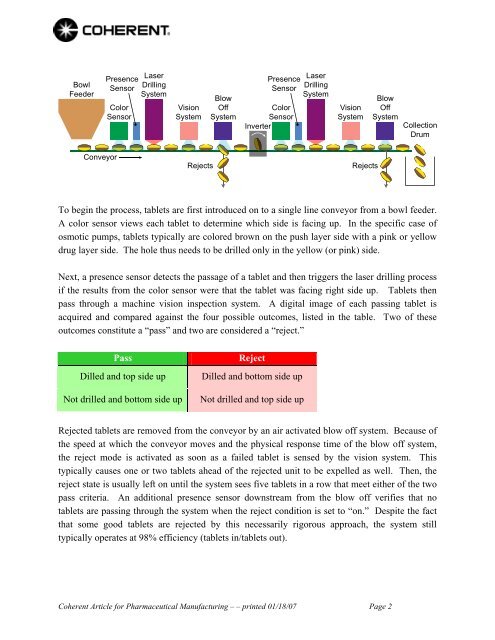Laser Drilling Enables Advanced Drug Delivery Systems - Coherent
Laser Drilling Enables Advanced Drug Delivery Systems - Coherent
Laser Drilling Enables Advanced Drug Delivery Systems - Coherent
Create successful ePaper yourself
Turn your PDF publications into a flip-book with our unique Google optimized e-Paper software.
Bowl<br />
Feeder<br />
Conveyor<br />
Presence<br />
Sensor<br />
Color<br />
Sensor<br />
<strong>Laser</strong><br />
<strong>Drilling</strong><br />
System<br />
Vision<br />
System<br />
Rejects<br />
Blow<br />
Off<br />
System<br />
Presence<br />
Sensor<br />
Color<br />
Sensor<br />
Inverter<br />
<strong>Laser</strong><br />
<strong>Drilling</strong><br />
System<br />
Vision<br />
System<br />
Rejects<br />
Blow<br />
Off<br />
System<br />
Collection<br />
Drum<br />
To begin the process, tablets are first introduced on to a single line conveyor from a bowl feeder.<br />
A color sensor views each tablet to determine which side is facing up. In the specific case of<br />
osmotic pumps, tablets typically are colored brown on the push layer side with a pink or yellow<br />
drug layer side. The hole thus needs to be drilled only in the yellow (or pink) side.<br />
Next, a presence sensor detects the passage of a tablet and then triggers the laser drilling process<br />
if the results from the color sensor were that the tablet was facing right side up. Tablets then<br />
pass through a machine vision inspection system. A digital image of each passing tablet is<br />
acquired and compared against the four possible outcomes, listed in the table. Two of these<br />
outcomes constitute a “pass” and two are considered a “reject.”<br />
Pass Reject<br />
Dilled and top side up Dilled and bottom side up<br />
Not drilled and bottom side up Not drilled and top side up<br />
Rejected tablets are removed from the conveyor by an air activated blow off system. Because of<br />
the speed at which the conveyor moves and the physical response time of the blow off system,<br />
the reject mode is activated as soon as a failed tablet is sensed by the vision system. This<br />
typically causes one or two tablets ahead of the rejected unit to be expelled as well. Then, the<br />
reject state is usually left on until the system sees five tablets in a row that meet either of the two<br />
pass criteria. An additional presence sensor downstream from the blow off verifies that no<br />
tablets are passing through the system when the reject condition is set to “on.” Despite the fact<br />
that some good tablets are rejected by this necessarily rigorous approach, the system still<br />
typically operates at 98% efficiency (tablets in/tablets out).<br />
<strong>Coherent</strong> Article for Pharmaceutical Manufacturing – – printed 01/18/07 Page 2


